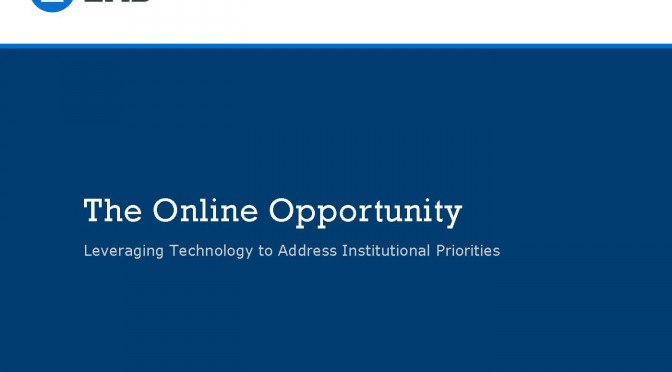Corequisite remediation is one of several strategies colleges are using to increase the outcomes of students who test into developmental education.
Monthly Archives: March 2016
Link: 3 Online Education Trends That Will Shape How You Hire in 2016
The CEO of Coursera shares three trends that he thinks will shape the relationship between education and employment in the near future:
- Job Seekers Will Build Portfolios of Online Certificates, the New Currency for Skills
- Learning Will Become the Most Coveted Perk at Hot Employers
- The World Will Become Your Hiring Pool
Link: How Faculty Learn To Teach Online: What Administrators Need to Know
Research shows most teachers teach as they were taught. However, distance educators lack a model or benchmark for online teaching because many of them have not taken online courses as students. Indeed, many studies on teaching online point to the importance of training for online instructors. Few studies go into specifics about exactly what that training should look like. The purpose of this study is to examine best practices in professional development for instructors learning to teach online.
Link: More Colleges Turn to “Stackable” Degrees as Entries to Graduate Programs
The University of Illinois is rolling out an online master’s in data science, which will be offered in conjunction with Coursera. The new degree costs $19,200, and builds on the certificates of completion already associated with the university’s pre-existing Coursera MOOCs.
Students who have already received those certificates will have a head start toward finishing the new degree, since those certificates make up two of the four distinct areas of study. The others are data visualization and machine learning. If admitted into the program, students could trade in those certificates for course credit.
Link: Competency For The Traditional Age Student
Purdue University is launching a competency-based interdisciplinary bachelor’s degree, which will combine technical and humanities fields. It was recently approved by Purdue’s regional accreditor.
Purdue’s degree track is based on the credit-hour standard, in which the demonstration of competencies is linked to corresponding college credit. This approach differs from relatively new competency-based offerings from a handful of other institutions, which use a method called direct assessment. That model is completely untethered from the credit hour, and students can move on as soon as they demonstrate mastery of required concepts.
At Purdue, however, studio and seminar-style “learning environments” will account for 35 percent of students’ plan of study.
Fain, Paul. “Competency for the Traditional Age Student.” Inside Higher Ed, March 30, 2016.
Link: Students Favor Summer Online Courses for Convenience
A summary of how summer online courses are developed at the University of Connecticut, and the value they add to the undergraduate residential experience.
Every year, the university offers 35 to 40 new online courses for its shortened summer session, a popular time for students to earn credits away from campus, Associate Director of UConn eCampus Desmond McCaffrey said.
Wright, Bailey. “Students Favor Summer Online Courses for Convenience.” Daily Campus, 3.2.16.
File: EAB Presentation to UO: The Online Opportunity
An updated version of this Education Advisory Board presentation, given to the online/hybrid task force on March 7, 2016.
[embeddoc url=”https://blogs.uoregon.edu/edtechknowledge/files/2016/03/EAB-The-Online-Opportunity-University-of-Oregon-03-07-16-1iy2oec.pdf” download=”all” viewer=”google”]
